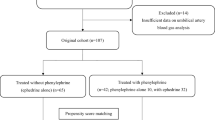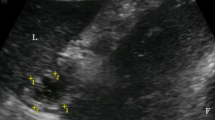Abstract
Although postoperative renal dysfunction is relatively rare after cesarean delivery, preeclampsia is considered as the high-risk population. On the other hand, hydroxyethyl starch (HES) administration for preventing maternal hypotension induced by spinal anesthesia for cesarean delivery is a common practice. However, the effect of HES administration during cesarean delivery on postoperative kidney function in parturients with severe preeclampsia is not well investigated. We retrospectively reviewed both medical and anesthesia records of patients with severe preeclampsia who underwent cesarean delivery from January 2011 to December 2013. Preoperative blood examinations were compared with postoperative values. All parturients received 6% HES 70/0.5 for preventing anesthesia-induced hypotension or for volume resuscitation during cesarean delivery. A total of 87 severe preeclampsia parturients were underwent cesarean section during the period. The amounts of HES administration were 859 ± 206 mL. There was significant reduction in serum creatinine, from 0.70 ± 0.29 mg/dL preoperatively to 0.62 ± 0.17 mg/dL in 3–7 days after the cesarean. Only one patient had postoperatively elevated serum creatinine up to clinically significant level (from 0.64 mg/dL to 1.35 mg/kg).

Similar content being viewed by others
References
Practice guidelines for obstetric anesthesia: an updated report by the American Society of Anesthesiologists Task Force on Obstetric Anesthesia and the Society for Obstetric Anesthesia and Perinatology. Anesthesiology. 2016;124:270–300.
Lirk P, Haller I, Wong CA. Management of spinal anaesthesia-induced hypotension for caesarean delivery: a European survey. Eur J Anaesthesiol. 2012;29:452–3.
Fadnes HO, Oian P. Transcapillary fluid balance and plasma volume regulation: a review. Obstet Gynecol Surv. 1989;44:769–73.
Sibai BM, Mabie WC. Hemodynamics of preeclampsia. Clin Perinatol. 1991;18:727–47.
Boyd JH, Forbes J, Nakada TA, Walley KR, Russell JA. Fluid resuscitation in septic shock: a positive fluid balance and elevated central venous pressure are associated with increased mortality. Crit Care Med. 2011;39:259–65.
Myburgh JA, Finfer S, Bellomo R, Billot L, Cass A, Gattas D, Glass P, Lipman J, Liu B, McArthur C, McGuinness S, Rajbhandari D, Taylor CB, Webb SA. Hydroxyethyl starch or saline for fluid resuscitation in intensive care. N Engl J Med. 2012;367:1901–11.
Perner A, Haase N, Guttormsen AB, Tenhunen J, Klemenzson G, Åneman A, Madsen KR, Møller MH, Elkjær JM, Poulsen LM, Bendtsen A, Winding R, Steensen M, Berezowicz P, Søe-Jensen P, Bestle M, Strand K, Wiis J, White JO, Thornberg KJ, Quist L, Nielsen J, Andersen LH, Holst LB, Thormar K, Kjældgaard AL, Fabritius ML, Mondrup F, Pott FC, Møller TP, Winkel P, Wetterslev J. Hydroxyethyl starch 130/0.42 versus Ringer’s acetate in severe sepsis. N Engl J Med. 2012;367:124–34.
Suzuki T, Miyao H, Terui K, Koyama K, Shiibashi M. Fluid therapy with hydroxyethyl starch for massive blood loss during surgery. J Anesth. 2010;24:418–25.
Endo A, Uchino S, Iwai K, Saito K, Sanui M, Takinami M, Uezono S. Intraoperative hydroxyethyl starch 70/0.5 is not related to acute kidney injury in surgical patients: retrospective cohort study. Anesth Analg. 2012;115:1309–14.
Jia RZ, Qian YJ, Zhang X, Ding HJ, Wu HQ, Shao KM. Contribution of dysfunction of maternal hemodynamics to renal impairment in preeclampsia. Gynecol Obstet Investig. 2013;76:95–9.
Gurrieri C, Garovic VD, Gullo A, Bojanic K, Sprung J, Narr BJ, Weingarten TN. Kidney injury during pregnancy: associated comorbid conditions and outcomes. Arch Gynecol Obstet. 2012;286:567–73.
Dunlop W. Serial changes in renal haemodynamics during normal human pregnancy. Br J Obstet Gynaecol. 1981;88:1–9.
Irons DW, Baylis PH, Davison JM. Effect of atrial natriuretic peptide on renal hemodynamics and sodium excretion during human pregnancy. Am J Physiol Renal Fluid Electrolyte Physiol. 1996;271:F239–42.
Dickenmann M, Oettl T, Mihatsch MJ. Osmotic nephrosis: acute kidney injury with accumulation of proximal tubular lysosomes due to administration of exogenous solutes. Am J Kidney Dis. 2008;51:491–503.
Mercier FJ. Cesarean delivery fluid management. Curr Opin Anaesthesiol. 2012;25:286–91.
Clark VA, Sharwood-Smith GH, Stewart AV. Ephedrine requirements are reduced during spinal anaesthesia for caesarean section in preeclampsia. Int J Obstet Anesth. 2005;14:9–13.
Aya AG, Mangin R, Vialles N, Ferrer JM, Robert C, Ripart J, de La Coussaye JE. Patients with severe preeclampsia experience less hypotension during spinal anesthesia for elective cesarean delivery than healthy parturients: a prospective cohort comparison. Anesth Analg. 2003;97:867–72.
Spaan JJ, Ekhart T, Spaanderman ME, Peeters LL. Renal function after preeclampsia: a longitudinal pilot study. Nephron Clin Pract. 2012;120:c156–61.
Acknowledgements
We would like to thank Professor Emeritus Hideki Miyao, Department of Anesthesia, Saitama Medical Center, Saitama Medical University, for his dedicated support and helpful discussion regarding basic physiology of fluid therapy.
Author information
Authors and Affiliations
Corresponding author
Ethics declarations
Conflict of interest
This study received no external funding. All authors have no conflict of interests to declare.
About this article
Cite this article
Mazda, Y., Tanaka, M., Terui, K. et al. Postoperative renal function in parturients with severe preeclampsia who underwent cesarean delivery: a retrospective observational study. J Anesth 32, 447–451 (2018). https://doi.org/10.1007/s00540-018-2492-x
Received:
Accepted:
Published:
Issue Date:
DOI: https://doi.org/10.1007/s00540-018-2492-x




